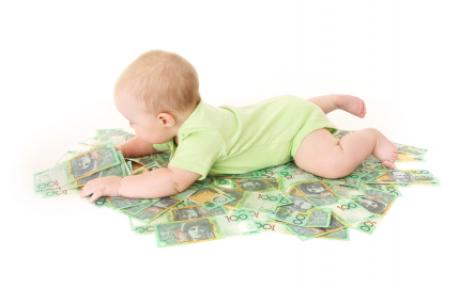The cost of raising a baby from birth to 4 years of age has been estimated at $11.3 billion this financial year or $7,098 per child. The costs cover nappies, clothing, food, furniture, toys, footwear and childcare and were calculated by business analysts IBISWorld. Excluding childcare, the cost is $3,037 per child.
“Childcare is by far the biggest expenditure for new parents and the biggest benefactor of baby spending,” says Karen Dobie, General Manager of IBISWorld.
“Close to 50% of children aged up to four years use day-care services.”
Ms Dobie says the increase in the number of working parents is the primary driver of demand and childcare revenue, which is expected to reach over $6.6 billion in 2013-14, a 18.9% increase in five years from 2008-09.
“Formal childcare options are the most common for children aged 12 months to four years old, but the use of nannies has also increased over the past decade due to the increased flexibility offered and the growing difficulty in securing a spot in formal childcare.”
Outside of childcare, IBISWorld highlighted clothing, food and nappies as the next biggest revenue earners from tots, while other merchandise and furniture round out the top five product expenditures. (For example, see our article on Nursery Style).
“For the average Aussie parent, rising home-safety awareness has been the key spending driver in readying the nursery and home to welcome a new baby.”
Spending trends
“While total expenditure on baby products and services has increased by 14.5% over the past five years, the structure of this has changed – with products such as clothing, nappies and furniture declining in overall contribution,” says Ms Dobie.
“This is largely attributed to high levels of imports from low-cost manufacturing nations, as well as the proliferation of cheaper online sales.”
IBISWorld highlighted food and nutrition, and specialised merchandise as the two biggest growth areas, with revenue in these markets expected to increase by 44.9% and 84.8%, respectively, over the next five years.
“When it comes to food, parents are becoming more conscious in ensuring their young ones consume optimal nutrition, driving a surge in premium baby food. Alongside this, mothers are breastfeeding for shorter periods due to their busy schedules and lifestyle pressures – such as returning to work shortly after birth. This is driving sales in alternatives, including organic infant formula, milk-free and gluten-free ranges,” Ms Dobie says.
Modern day families
The family unit has changed significantly over the past few decades, with the number of separations and divorces, remarriages, single parents and same-sex parents increasing.
However, the average number of children per family has remained relatively flat, falling from 2.1 in 1975 to 1.9 in 2011.
Ms Dobie noted that there has been a significant change to the way these families come into being – with fertility clinics and adoption growing in popularity.
“In the coming year the combined revenue to fertility clinics from IVF and other services is forecast to reach close to $550 million, a 110% increase from five years ago.”
Ms Dobie says that almost one in six couples suffer fertility issues.
“With the average age of new parents – currently at 33 for men and 30 for women – expected to continue to increase, so too is this figure,” she says.



















__small.png)










